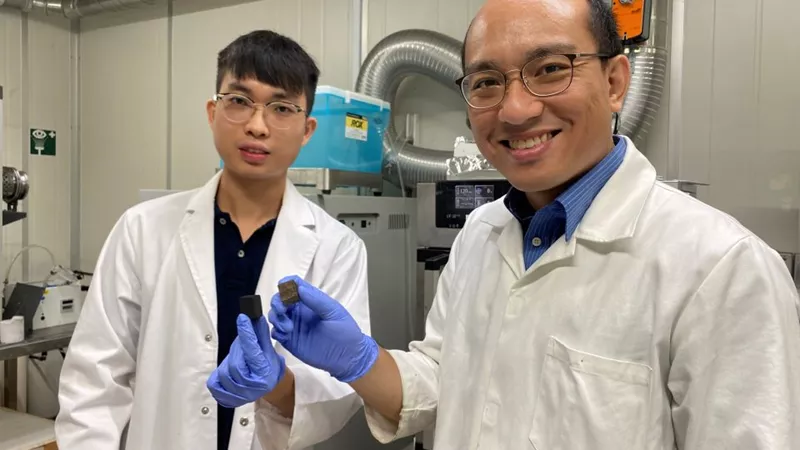Scientists have used carbonisation to convert waste paper – from single-use packaging and bags, and cardboard boxes – into electrodes for lithium-ion batteries.
Mr Lim Guo Yao, a research engineer from NTU’s School of Mechanical & Aerospace Engineering and Assistant Professor Lai Changquan, from NTU’s School of Mechanical & Aerospace Engineering, presenting the anodes created using the NTU-developed technique – NTU Singapore
To carbonise the paper, the research team at Nanyang Technological University, Singapore (NTU Singapore) exposed the paper to high temperatures, which reduces it to pure carbon, water vapour and oils that can be used for biofuel. As carbonisation takes place in the absence of oxygen, the process emits negligible amounts of carbon dioxide, and the process is claimed to be a greener alternative to disposing of kraft paper through incineration.
According to NTU, the carbon anodes also demonstrated superior durability, flexibility, and electrochemical properties. Laboratory tests showed that the anodes could be charged and discharged up to 1,200 times, and withstand more physical stress than their counterparts, absorbing crushing energy up to five times better.
The NTU-developed method also uses less energy-intensive processes and heavy metals compared to current industrial methods of manufacturing battery anodes. As the anode is worth 10 per cent to 15 per cent of the total cost of a lithium-ion battery, this latest method, which uses a low-cost waste material, is expected to also bring down the cost of manufacturing them.
Using waste paper as the raw material to produce battery anodes would also ease reliance on conventional sources for carbon, such as carbonaceous fillers and carbon-yielding binders, which are mined and later processed. The team’s findings have been published in Additive Manufacturing.
In a statement, study co-author Lim Guo Yao, a research engineer from NTU’s School of Mechanical & Aerospace Engineering, said: “Our anodes displayed a combination of strengths, such as durability, shock absorption, electrical conductivity, which are not found in current materials. These structural and functional properties demonstrate that our kraft paper-based anodes are a sustainable and scalable alternative to current carbon materials, and would find economic value in demanding, high-end, multifunctional applications, such as the nascent field of structural batteries.”
To produce the carbon anodes, the NTU researchers joined and laser cut several thin sheets of kraft paper to form different lattice geometries. The paper was then heated to 1200°C in a furnace without the presence of oxygen, to convert it into carbon, forming the anodes.
The NTU team attributes the anode’s superior durability, flexibility, and electrochemical properties to the arrangement of the paper fibres. They said the combination of strength and mechanical toughness shown by the NTU-made anodes would allow batteries of phones, laptops and automobiles to better withstand shocks from falls and crashes.
The NTU team will be conducting further research to improve the energy storage capacity of their material and minimise the heat energy required to convert the paper into carbon. The team has filed for a patent with NTUitive, NTU’s innovation and enterprise company, and is working towards commercialising their invention.

